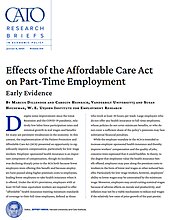Despite some improvement since the Great Recession and the COVID-19 pandemic, relatively low labor force participation rates and minimal growth in real wages and benefits for many are persistent weaknesses in the economy. In this context, the implementation of the Patient Protection and Affordable Care Act (ACA) presented an opportunity to significantly improve compensation, particularly for low-wage workers. Employer-sponsored health insurance is an important component of compensation, though its incidence was declining sharply prior to the ACA both because fewer employers were offering this benefit and because employers have passed along higher premium costs to employees, leading fewer employees to take health insurance when it is offered. Under the ACA’s provisions, employers with at least 50 full-time-equivalent workers are required to offer “affordable” health insurance meeting minimum standards of coverage to their full-time employees, defined as those who work at least 30 hours per week. Large employers who do not offer any health insurance to full-time employees, whose policies do not cover minimum benefits, or who do not cover a sufficient share of the policy’s premium may face substantial financial penalties.
While the employer mandate in the ACA is intended to increase employer-sponsored health insurance and thereby improve workers’ compensation and the quality of jobs, concerns were expressed that it could backfire. In theory, to the degree that employees value the health insurance benefit offered, employers may pass along the premium costs to workers in the form of lower real wages or other reduced benefits. Particularly for low-wage workers, however, employers’ ability to lower wages may be constrained by the minimum wage. Moreover, employers may avoid cutting nominal wages because of adverse effects on morale and productivity, and inflation may not be a viable mechanism to reduce real wages if the relatively low rates of price growth of the past persist.
Alternatively, large employers may increase their use of workers in staffing arrangements that are not covered by the employer mandate: workers averaging less than 30 hours per week or working in organizations with fewer than 50 full-time employees. Federal rules stipulate that to determine work hours for a particular employee, an employer may use up to a 12-month “look back” period to establish whether an employee works an annual average of 30 hours per week.
As a result, employers are not required to offer insurance to many, if not most, on-call and temporary workers. To circumvent the mandate, therefore, employers may choose to reduce standard weekly hours below 30 or shift their mix of staffing toward greater use of on-call, direct-hire temporaries or agency temporaries. Additionally, employers may choose to outsource certain tasks to firms with fewer than 50 full-time employees. Ironically, the employer mandate could reduce the quality of jobs for low- and mid-skill workers by increasing the share of low-hours, part-time (defined as averaging less than 30 hours per week); temporary; and contract employment—categories that often are associated with relatively low compensation and job instability.
Reflecting such concerns, a July 2013 letter from three of the largest labor unions to congressional leaders argued that the law would “shatter not only our hard-earned health benefits, but destroy the foundation of the 40 hour work week that is the backbone of the American middle class.” The union leaders argued, and some public accounts confirmed, that employers would be incentivized to keep or cut workers’ hours to below 30 per week to avoid the obligation to provide insurance. For example, by September 2014, several months before the mandate took effect for employers with at least 100 full-time-equivalent workers, Investor’s Business Daily had compiled a list of 450 public and private employers for which it claims there was strong proof (i.e., official documents or accounts) that these employers had cut work hours from full- to part-time or reduced hours of new hires to be less than 30 to circumvent the health insurance benefit requirement. Similarly, industry analysts predicted a boost to temporary-help firms from the ACA.
Our research sheds light on the early effects the ACA employer mandate had on low-hours, part-time employment. In our analysis, we distinguished between part-time employment for personal reasons and part-time employment for economic reasons. The latter should best capture any changes owing to an increase in employer demand for low-hours, part-time employment. In past work, we estimated that around the time of the ACA’s passage, about 5 percent of the wage and salary workers were vulnerable to changes in their employment arrangement, and we argued that if employers chose to circumvent the mandate, the mechanisms would likely vary across industries according to the organization of production and established staffing practices. The relatively small share of the workforce potentially affected by the mandate implies that any impacts on hours may be difficult to detect empirically outside industries with a high share of such workers and in which use of low-hours, part-time workers is an attractive alternative.
To investigate this concern, we employed a research strategy that compares Hawaii with the rest of the nation. Hawaii has had, for several decades, a more stringent employer health insurance mandate than that contained in the ACA. Consequently, the introduction of the mandate in the ACA should have no effect on employer behavior in that state. Although Hawaii is in many ways a unique state, using monthly data from the Current Population Survey we found that part-time employment in Hawaii closely tracks part-time employment in the rest of the nation prior to the passage of the ACA. Using the same data, we estimated that the ACA increased low-hours, involuntary parttime employment by 2–3 percentage points, or 500,000 to 1 million workers, in retail, accommodations, and food services—the sectors where employers are most likely to reduce hours if they choose to circumvent the mandate.
NOTE
This research brief is based on Marcus Dillender et al., “Effects of the Affordable Care Act on Part-Time Employment: Early Evidence,” Upjohn Institute Working Paper no. 16–258, June 2016.

This work is licensed under a Creative Commons Attribution-NonCommercial-ShareAlike 4.0 International License.
